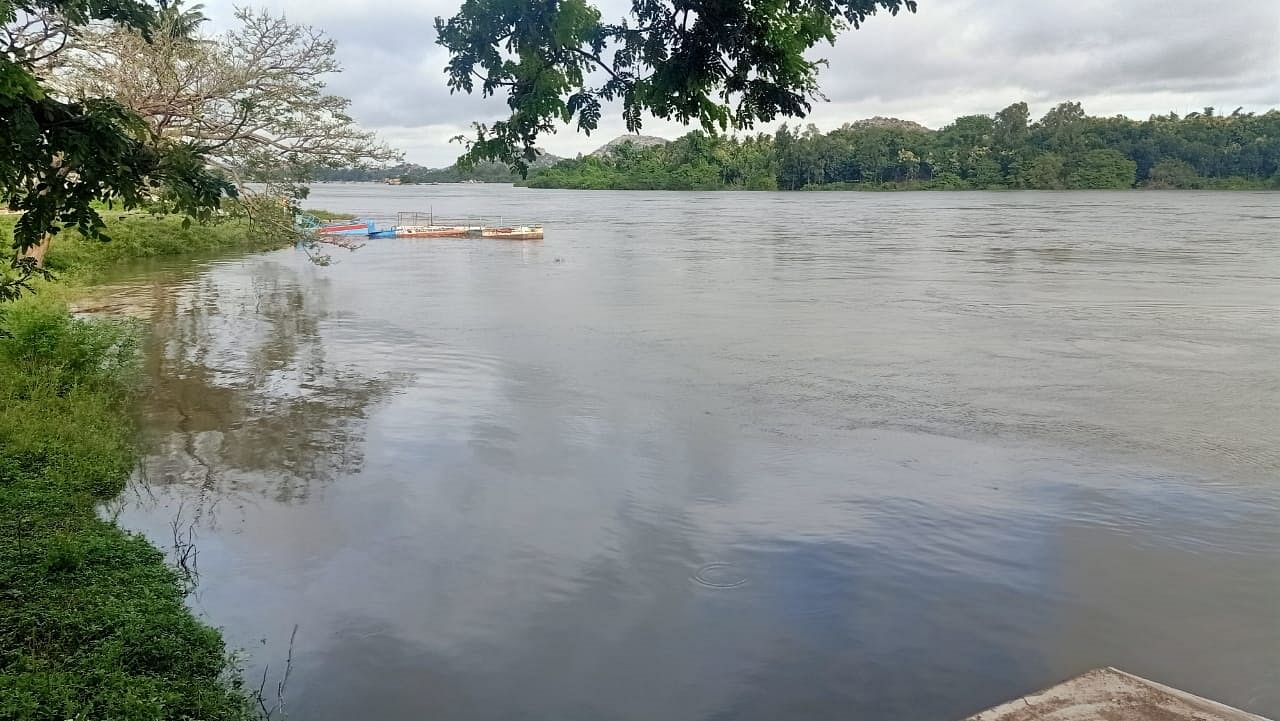
Tungabhadra River, which flows in nine districts, has the highest number of vulnerable villages.
Credit: DH Photo
The state government has identified 1,698 villages as being vulnerable to riverine floods, while 1,351 villages are at risk of landslides. The list has been drawn up based on historic data, local topography, and their geographic location.
Officials of the Karnataka State Disaster Management Cell, Fire and Emergency, and Revenue departments, are working in concert to pre-empt potentially calamitous situations. Besides allocating materials required to deal with such natural disasters, personnel have also been stationed at locations close to the vulnerable 14villages.
Of the 1,698 villages deemed vulnerable to riverine floods, 1,478 are in the Krishna Basin, of which 643 are at ‘very high-risk’, and 835 are ‘at moderate risk’.
In South Karnataka, 124 villages in the Cauvery Basin have made it to the department’s list; of these, 54 are at ‘very high-risk’, while 70 are at ‘moderate risk’. The department has identified a further 96 villages in the basins of rivers flowing westwards, with 60 being classified under the ‘very high-risk’ category.
238 villages in Kalaburagi district at risk
Vulnerable villages in the Krishna River Basin have been further classified and grouped under its tributaries, the Tungabhadra and Bhima. In the Tungabhadra Basin, spread across nine districts, 592 villages are at risk of flooding . Of the 292 villages in the Bhima River Basin at risk of riverine floods, 238 are in Kalaburagi district. With 23 of the 31 districts in the state deemed susceptible to floods, the government has issued directions to the officials concerned in all these districts to regularly monitor the progress of the monsoon lest they are caught unprepared for any calamities.
Officials in Belagavi, Raichur, Koppal, Ballari, Gadag, Haveri, Shivamogga, Davanagere, Bagalkote, Yadgir, and Mysuru districts have been instructed to be prepared to tackle challenges that will follow in the wake of excess rainfall.
Western Ghats on a ‘slippery’ slope
In all, 1,351 villages in seven districts in the Western Ghats have been deemed ‘vulnerable’ to landslides, with Uttara Kannada accounting for 616, followed by Shivamogga (374), Chikkamagluru (209), Dakshina Kannada (51), Kodagu (45), Hassan (40), and Udupi (16).
Analysis of government data from 2022, when the state suffered significant damage owing to heavy rainfall, shows that 82 people lost their life, while 462 livestock died. The flood also damaged 24,408 houses, in addition to 1,471 bridges or culverts, 6,998 school buildings, 236 primary health centres (PHCs), and 3,789 anganwadi centres.
Revenue Department (Disaster Management) principal secretary V Rashmi Mahesh said, “We are constantly monitoring the water level in the reservoirs. Nodal officers in each district have been asked to follow the SOP in the event of a flood.”
She said that officials had been asked to ascertain strength of buildings, particularly those housing anganwadis and schools. “These will temporarily shelter those affected by floods. Local bodies have been tasked with de-silting storm water drains to ensure unchecked flow of rainwater,” said Rashmi, adding five units of the State Disaster Response Force (SDRF) had been deployed in Bengaluru, Mangaluru, Davanagere, Kalaburagi, and Belagavi, to minimise response time.
The government has also strengthened the Fire and Emergency Services department, personnel of which will assist other agencies in the vulnerable villages. Director of the Karnataka State Fire and Emergency Service Department Shivashankar TN said that all 216 fire stations across the state were prepared to tackle adverse situations. “We have deployed 5,000 personnel to our stations, and we will be assisted by around 150 to 200 personnel from the SDRF and the NDRF. We have ensured that all the stations are well equipped,” Shivashankar said.
Dealing with flash floods
However, officials in the disaster management cell are more concerned about flash floods. Bengaluru, for instance, has been bearing the brunt of flash floods in the recent past.
However, Shivashankar is confident of the department’s ability to cope with flash floods and other such unprecedented situations. “Personnel attached to 20 fire stations in a three or four-kilometre radius will work in tandem to mitigate the impact of flash floods in the affected localities. All the agencies are co-ordinating with the BBMP. We have also set up round-the-clock control rooms to ensure speedy response,” he added.